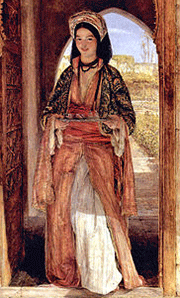E-Archive
Off the Beaten Track
in Vol. 15 - May Issue - Year 2014
Spirited Goats

Anyone for a good espresso?

Serving coffee in the Ottoman district in Cairo, 1857
Kaldi couldn't sleep. He had been tossing and turning for the past two hours. Normally he would collapse on the coarse mat and immediately fall into a deep slumber, but tonight was different. The goats outside his tent were restless and Kaldi was worried that their continuous bleating and sudden dashes to and fro might indicate the presence of a predator. But he had already gotten up three times and had carefully checked the perimeter of the flimsy wooden stockade without seeing anything suspicious. Yet there was something making the goats nervous...
*****
This is one of several legends that are told to explain how the stimulating properties of coffee were discovered and how people learned to make what was to become, together with tea, the most popular hot beverage in the world. In the case of the goatherd who tended his flock in the Ethiopian highlands in the ninth century, it is said that he observed that his goats would become spirited and would not go to sleep at night after eating the bright red berries of a certain bush that grew abundantly in the surrounding plains. After tasting the berries himself, he noticed that he would be energized and alert long after he would have normally fallen asleep. Kaldi reported his discovery to the abbot of the local monastery, who tasted the berries and roasted them in an attempt to make them less bitter. From there came the idea to roast the seeds extracted from the berries and to boil them in water.
Regardless of whether this story is fact or legend, it is certain that the Coffea plant originated in Ethiopia. By the fourteenth century this evergreen shrub was being cultivated in Eastern Africa and in the Southern Arabian Peninsula. Consumption of brewed coffee was first documented in the fifteenth century and at first was restricted to religious practices in monasteries. The brew became more and more popular and, by the middle of the century, the first coffeehouses had opened in Yemen. By the sixteenth century, coffee drinking had spread to Egypt, Syria, Turkey and Persia, at that time all territories under the Ottoman Empire, and during the seventeenth century it had become common in Western Europe as well.
Seeing the profits to be made, the Arabs attempted to keep their monopoly on the cultivation of coffee plants, but within a few years several traders had managed to smuggle some plants out of the Arabian Peninsula. From there the coffee plant was carried to European colonies in the Americas, Africa and Asia.
Coffeehouses soon became popular meeting places, where for the price of a cup of coffee people could gather to talk, read and discuss current social and political affairs. Heads of state and religious leaders soon became suspicious of these institutions, which they viewed as hotbeds of dissension and revolt. Coffeehouses and the drinking of coffee were banned for a certain period in the Ottoman Empire on the basis of moral and religious dogmas. By the late 1600's there were over 3,000 coffeehouses in England, but nevertheless King Charles II attempted to shut them down, after branding them as "places where the disaffected met, and spread scandalous reports concerning the conduct of His Majesty and his Ministers". In the Christian West, many clergymen called for the banning of what they considered "the devil's brew" and the controversy flared so strongly that Pope Clement III was forced to intervene, giving the drink his approval only after personally tasting it and finding it very satisfying.
It appears that the word for coffee entered Western European languages through the Italian word caffè, which derived from the Ottoman Turkish word kahve, which in turn came from the Arabic qahwah. This is because trade with the Middle East in the sixteenth and seventeenth centuries was a virtual monopoly of the Republic of Venice, whose mighty merchant navy plied the Eastern Mediterranean on a regular basis. It's not a coincidence that the first coffeehouses in Western Europe appeared in Venice in the seventeenth century, with one of these establishments still operating to this day in Saint Mark's Square.
Coffee plants are now cultivated in over seventy countries, primarily in the equatorial regions of Latin America, Africa and Southeast Asia. In 2011 green coffee bean production worldwide had reached a total of eight million metric tons. Five countries, Brazil, Vietnam, Indonesia, Colombia and Ethiopia accounted for almost sixty-five percent of this volume.
By Giovanni Gregorat, Contributing Editor MFN
Author: Giovanni Gregorat


























